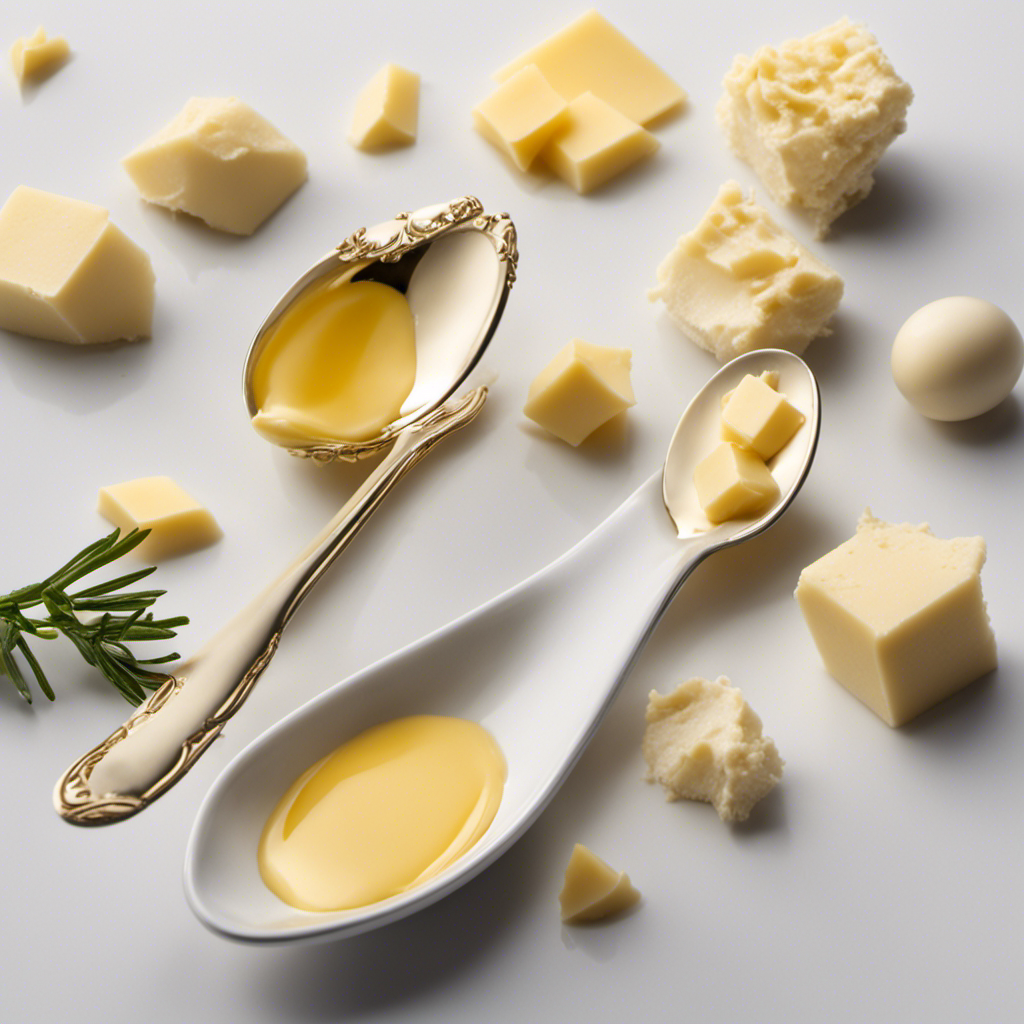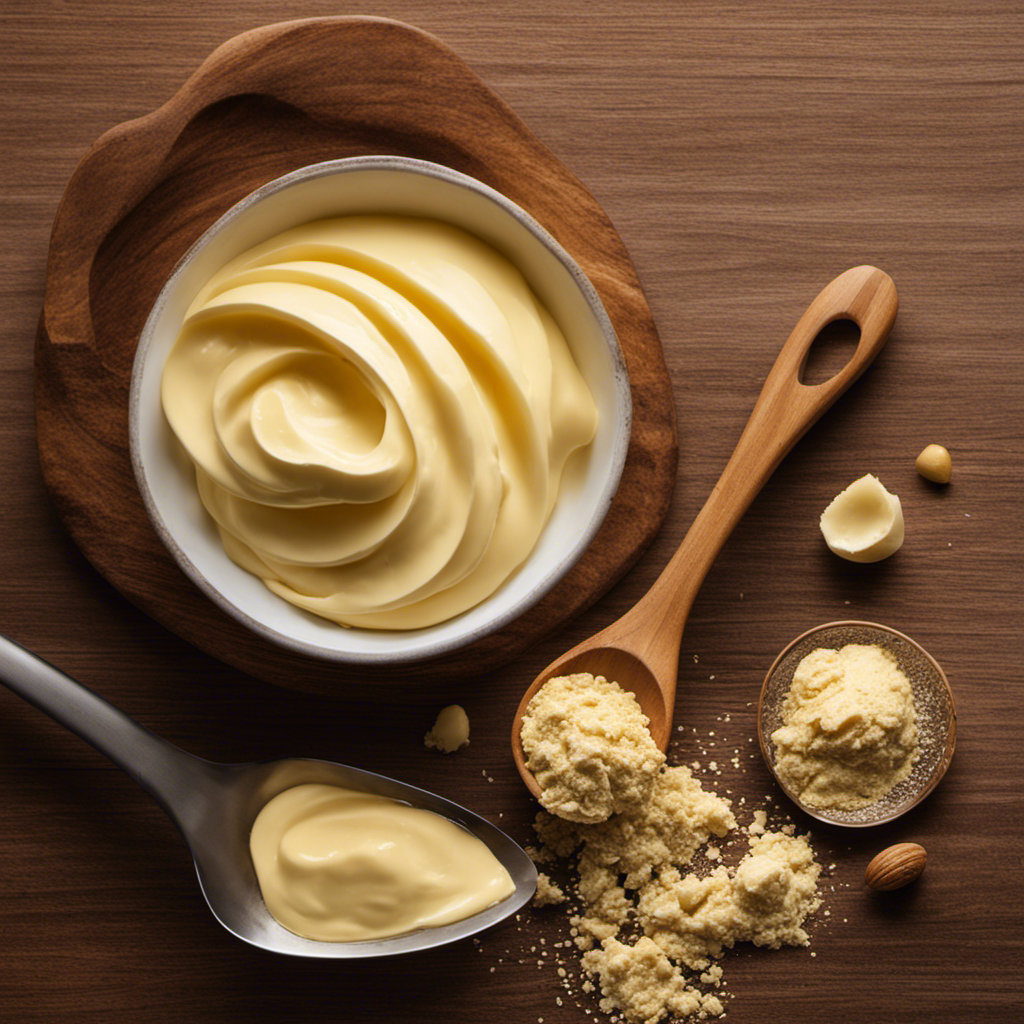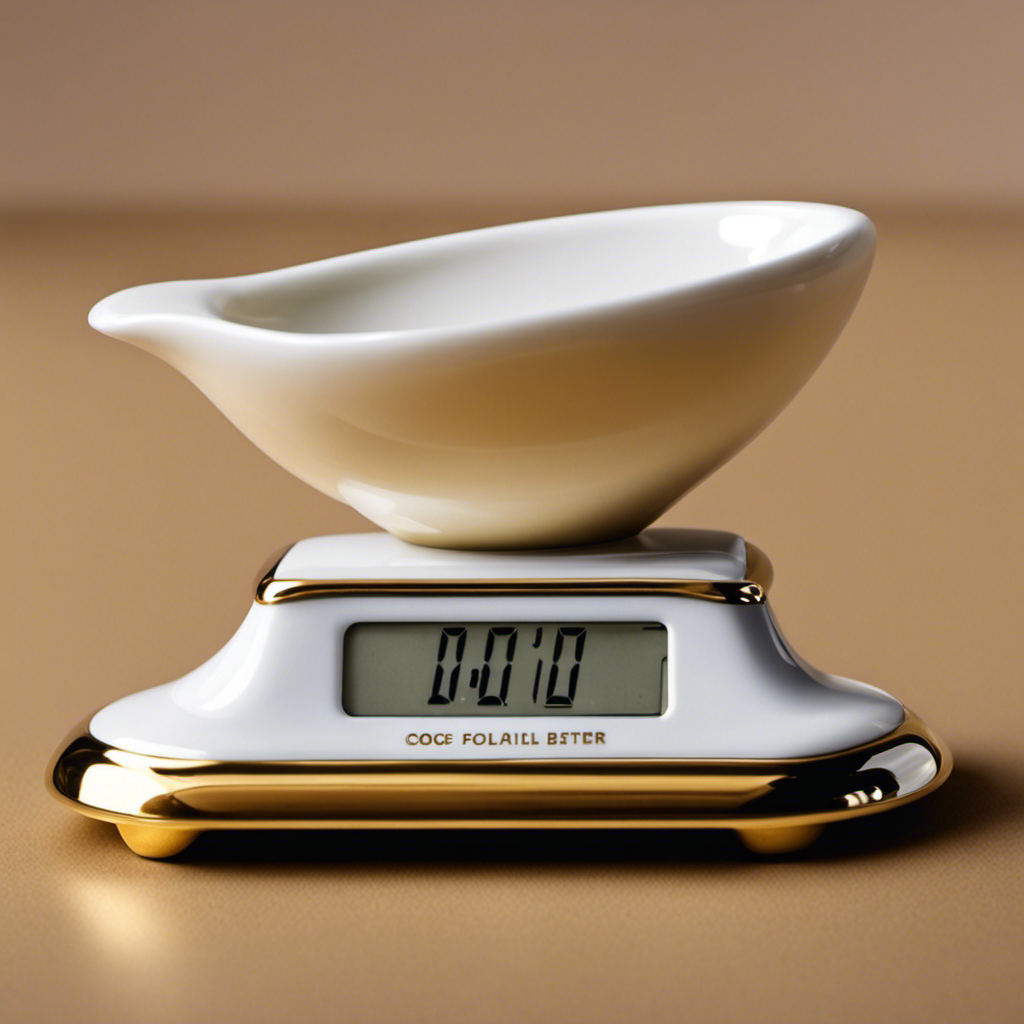I have always been curious about the number of calories in a small teaspoon of butter. It is a sneaky ingredient that can quickly accumulate without us noticing.
So, I decided to do some digging and uncover the truth. In this article, we’ll explore the caloric content of butter and break down just how many calories that innocent little teaspoon can really contribute to our daily intake.
Get ready to be surprised!
Key Takeaways
- Butter has a high caloric value, with approximately 34 calories in one teaspoon.
- Consuming too much butter, which is high in saturated fats, can increase the risk of heart disease, weight gain, obesity, and diabetes.
- Butter can be a hidden source of calories in our diet, so portion control and mindful consumption are important.
- Healthier alternatives to butter, such as olive oil and avocado, can reduce calorie intake while providing essential nutrients and anti-inflammatory properties.
Understanding the Caloric Content of Butter
Understanding the caloric content of butter is important when considering how many calories are in a tsp of it.
Butter is known for its high caloric value, which can have a significant nutritional impact. In fact, one teaspoon of butter contains approximately 34 calories.
This means that even a small amount of butter can contribute a considerable number of calories to your daily intake.
It’s worth noting that butter is primarily composed of fat, specifically saturated fat. While fat is an essential macronutrient, consuming too much saturated fat can increase the risk of heart disease.
Therefore, it is important to be mindful of the portion size and frequency of butter consumption to maintain a healthy diet and manage calorie intake.
Butter: A Sneaky Source of Calories
When it comes to managing our calorie intake, it’s important to be aware of hidden sources of calories in our diet. One such sneaky culprit is butter, which can add up quickly if we’re not careful.
In this discussion, we’ll explore the hidden calorie content of butter and also look into some butter alternatives that can help us cut down on calories without sacrificing taste.
Hidden Calorie Content
There’s a lot of hidden calorie content in certain foods, like butter. While butter is delicious, it can also be high in fat and calories. One teaspoon of butter contains about 102 calories and 11.5 grams of fat. However, it’s not just the obvious fats that contribute to the calorie count.
There are also hidden fats in many processed foods that can add up quickly. That’s why it’s important to be mindful of your overall fat and calorie intake. If you’re looking for a healthier alternative to butter, there are several options available.
Butter substitutes, like olive oil or avocado, can provide a similar flavor and texture without the added fat and calories. Transitioning to these alternatives can help you reduce your calorie intake while still enjoying your favorite dishes.
Butter Alternatives
If you’re looking for a healthier alternative to butter, you can try using olive oil or avocado as substitutes. These butter alternatives not only provide a delicious flavor to your dishes but also offer several health benefits.
Here are three reasons why you should consider incorporating olive oil or avocado into your diet:
-
Heart-healthy fats: Both olive oil and avocado are rich in monounsaturated fats, which can help reduce bad cholesterol levels and promote heart health. These fats have been linked to a lower risk of heart disease.
-
Nutrient-rich: Olive oil and avocado are packed with essential vitamins and minerals, such as vitamin E, vitamin K, and potassium. These nutrients play a vital role in maintaining overall health and can support various bodily functions.
-
Anti-inflammatory properties: Olive oil and avocado contain antioxidants that have anti-inflammatory effects. Chronic inflammation is associated with various diseases, so incorporating these alternatives into your diet may help reduce inflammation in the body.
How Many Calories Does a Teaspoon of Butter Add
A teaspoon of butter adds calories to a dish. Butter is a popular ingredient in cooking and baking, known for its rich flavor and creamy texture. However, it is important to be mindful of the calorie count when using butter in our recipes. According to the United States Department of Agriculture (USDA), one teaspoon of butter contains approximately 34 calories. This small amount may not seem significant, but it can add up quickly, especially if we consume multiple servings or use larger quantities in our dishes. To provide a visual representation, here is a table showcasing the calories in different amounts of butter:
| Amount of Butter | Calories |
|---|---|
| 1 teaspoon | 34 |
| 1 tablespoon | 102 |
| 1/4 cup | 408 |
| 1/2 cup | 816 |
It is important to be mindful of our butter consumption and incorporate it into our diet in moderation to maintain a balanced calorie intake.
Counting Calories: The Butter Dilemma
Using butter in our recipes can quickly contribute to our daily calorie intake. It’s important to be mindful of portion size and understand the nutritional value of butter. Here are three key points to consider:
-
Portion Size Matters: Butter is high in calories, with about 102 calories per tablespoon. Be aware of how much butter you are using in your recipes to avoid excessive calorie intake.
-
Nutritional Value: While butter adds flavor and richness to dishes, it is also high in saturated fats. Consuming too much saturated fat can increase the risk of heart disease. Consider healthier alternatives like olive oil or avocado.
-
Moderation is Key: Rather than completely cutting out butter, it’s important to practice moderation. Use smaller amounts or explore healthier substitutes to reduce overall calorie intake while still enjoying the taste and texture butter adds to your favorite dishes.
Understanding the impact of butter on our calorie intake is essential for maintaining a balanced diet. Now, let’s unveil the truth: the calorie count in a teaspoon of butter.
Unveiling the Truth: Calorie Count in a Teaspoon of Butter
When it comes to watching my calorie intake, one thing I’ve always wondered about is the calorie content of butter.
In this discussion, I will delve into the truth behind the calorie count in a teaspoon of butter.
Additionally, I will provide some practical portion control tips to help manage butter consumption, and explore the potential health implications of consuming too much butter.
Butter Calorie Content
You can easily find the calorie content of butter by checking the nutrition label.
Here are three important points to help you understand butter nutrition and the health effects of butter:
-
Calorie content: Butter is high in calories. One teaspoon of butter contains approximately 36 calories. It is important to be mindful of portion sizes when consuming butter to manage calorie intake.
-
Nutrient profile: Butter is primarily composed of fat, specifically saturated fat. While it does contain small amounts of vitamins A, D, E, and K, it is not a significant source of other essential nutrients.
-
Health effects: Due to its high saturated fat content, excessive consumption of butter can contribute to an increased risk of heart disease and elevated cholesterol levels. It is recommended to consume butter in moderation as part of a balanced diet.
Understanding the calorie content and health effects of butter can help you make informed choices about your dietary intake.
Remember to prioritize a varied and balanced diet for overall health and well-being.
Portion Control Tips
To control your portion sizes of butter, it’s helpful to use a small spreader or knife. Portion control is important for maintaining a healthy diet and managing weight. By being mindful of the amount of butter we consume, we can enjoy its rich flavor without going overboard.
Here are some effective portion control strategies:
-
Measure your butter: Use a measuring spoon to accurately portion out the desired amount of butter.
-
Use a spreader or knife: By using a small utensil, you can better control the amount of butter you add to your food.
-
Opt for low-fat alternatives: Consider using low-fat spreads or substitutes to reduce calorie intake.
Health Implications Explored
Using portion control strategies and being mindful of your intake can have a positive impact on your overall health. Here are three ways in which practicing portion control can benefit your health:
-
Weight management: By controlling your portion sizes, you can prevent overeating and manage your weight effectively. This can reduce the risk of obesity and related health conditions such as heart disease, diabetes, and certain types of cancer.
-
Balanced nutrition: Portion control allows you to consume a variety of foods in appropriate amounts, ensuring a well-balanced diet. This helps you meet your nutritional needs and provides your body with essential vitamins, minerals, and other nutrients.
-
Blood sugar control: Overeating can lead to spikes in blood sugar levels, especially when consuming high-calorie foods. By practicing portion control, you can maintain stable blood sugar levels, which is crucial for individuals with diabetes or those at risk of developing the condition.
Decoding the Calorie Mystery: Butter’s Caloric Impact
Butter’s caloric impact can be decoded by understanding how many calories are in a teaspoon. When it comes to weight management, it is crucial to be aware of the calories we consume from butter. A teaspoon of butter contains approximately 102 calories, making it a dense source of energy. This means that even small amounts of butter can contribute significantly to our daily caloric intake. To put it into perspective, here is a table showcasing the calorie content of different amounts of butter:
| Amount of Butter | Calories |
|---|---|
| 1 teaspoon | 102 |
| 1 tablespoon | 306 |
| 1 cup | 1628 |
Understanding the calorie content of butter can help us make informed decisions about our butter consumption, allowing us to better manage our weight and overall health.
Frequently Asked Questions
Can Consuming Butter in Moderation Be Part of a Healthy Diet?
In moderation, butter can be part of a healthy diet. It is a source of healthy fats, but should be replaced with healthier alternatives like olive oil or avocado for optimal health benefits.
Are All Types of Butter the Same When It Comes to Calorie Content?
All types of butter have different calorie contents. Butter alternatives, like margarine, may have fewer calories. It’s important to consider the nutritional value of butter and choose options that fit into a healthy diet.
Does the Calorie Count in a Teaspoon of Butter Change When It Is Melted?
When butter is melted, it doesn’t change its calorie content. The calorie count remains the same, whether it’s solid or melted. So, melted butter doesn’t have fewer calories than solid butter.
How Does the Calorie Content of Butter Compare to Other Common Cooking Fats?
When comparing butter’s calorie content to other common cooking fats, it’s important to consider the type of fat. For example, coconut oil has more calories than butter. Comparing butter’s calorie content: a comprehensive analysis. Butter vs other cooking fats: which is higher in calories?
Is It Possible to Reduce the Calorie Content of Butter Through Cooking or Preparation Methods?
Reducing the calorie content of butter can be achieved through various cooking methods. By using low-fat alternatives, such as margarine or cooking sprays, you can lower the overall calorie intake while still enjoying the taste and nutritional value of butter.
Conclusion
In conclusion, understanding the caloric content of butter is crucial for those watching their calorie intake. It may come as a surprise that a mere teaspoon of butter adds about 36 calories to your meal.
This may not seem like much, but it can quickly add up if you’re not mindful of your portions. So, next time you reach for that butter knife, remember that even a small amount can have a significant impact on your overall calorie consumption.
Stay informed and make informed choices!










